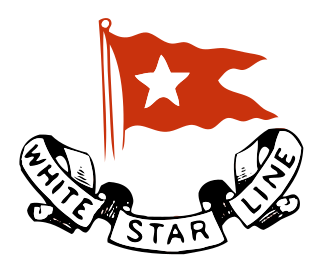
The White Star Line was a British shipping line. Founded out of the remains of a defunct packet company, it gradually rose up to become one of the most prominent shipping companies in the world, providing passenger and cargo services between the British Empire and the United States. While many other shipping lines focused primarily on speed, White Star branded their services by focusing more on providing comfortable passages for both upper class travellers and immigrants.

SS Akaroa was a UK steam ocean liner and refrigerated cargo ship. She was launched in 1914 in Ireland as Euripides for Aberdeen Line. When new, she was the largest ship in the Aberdeen Line fleet.
SS Santhia was a 5,544 GRT steam cargo liner built for the British-India Steam Navigation Company in 1901 by William Denny & Brothers, Dumbarton. She was sold to Japan in 1923 and was in service until 1935, when she was scrapped.
SS Mulbera was a British India Steam Navigation Company (BI) turbine steamship that was built in 1922 and scrapped in 1954. She belonged to BI's "M" class of cargo liners. She was the last member of the class to be built, and the last to survive in service.
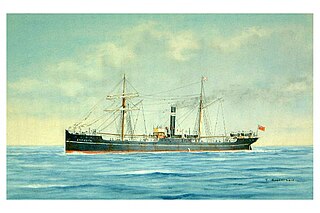
SS Camorta was an iron-hulled passenger steamship that was built in Scotland in 1880, and lost with all hands in the Irrawaddy Delta in 1902. The disaster killed more than 700 people.

Komagata Maru was a cargo steamship that was built in Scotland in 1890, was in German ownership until 1913, and then had a succession of Japanese owners until she was wrecked in 1926. She was launched as Stubbenhuk, renamed Sicilia in 1894, Komagata Maru in 1913 and Heian Maru in 1924.
MV Dwarka was a British India Steam Navigation Company passenger and cargo ship that operated between the Indian subcontinent and Persian Gulf. She was in service from 1947 until 1982. She was the second of four "modern D Class" sister ships built between 1946 and 1950, and the only one of the four to be built by Swan, Hunter & Wigham Richardson at Low Walker.
MV Domala was a British cargo liner that was launched in 1920 as Magvana, but completed in 1921 as Domala. She was the first major ocean-going passenger ship to be built in the United Kingdom as a motor ship.
MV Dumana was a British cargo liner that was laid down as Melma, but launched in 1921 as Dumana. She British India Steam Navigation Company (BI) owned her, and ran her on routes between London and India.
SS Gairsoppa was a British cargo steamship that was built in 1919 and sunk in the Battle of the Atlantic in 1941. 85 of her complement were killed, and only one person survived. When she was sunk, her cargo included 7 million ounces of silver bullion. In 2012 and 2013 a US company recovered part of the bullion, and in 2014 the Royal Mint struck 20,000 silver coins from it.

SS Karagola was a cargo steamship of the British India Steam Navigation Company (BI). She was built in Scotland in 1887, and operated a regular cargo, passenger and mail service in Burma. In 1901 a fire damaged her beyond repair, so she was scrapped.
SS Sirsa was a steel-hulled merchant steamship that was built in Scotland in 1883 and scrapped in Bombay in 1908. She spent her entire career with the British India Steam Navigation Company (BI).
SS Mantola was a British India Steam Navigation Company (BI) steamship that was built in 1916 and sunk by a German U-boat in 1917. She belonged to BI's "M" class of cargo liners. She was carrying an estimated 600,000 ounces of silver bullion when she was sunk. In 2017, 526 bars of silver were salvaged from the wreck and taken to the United Kingdom, in circumstances that remain undisclosed.
SS Hatarana was a cargo steamship that was built as part of an emergency shipbuilding programme during the First World War, and sunk without loss of life in the Battle of the Atlantic during the Second World War. She was built as War Sailor, one of a batch of cargo ships that the United Kingdom ordered from Japanese shipyards. She was renamed Hatarana in 1919 when she changed owners.
SS Maasdam was a Dutch turbine steamship that was launched in 1920 and sunk in 1941. She was the third Holland America Line ship to be named after the village of Maasdam in South Holland.
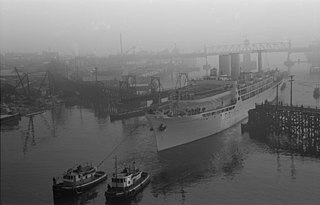
HMS Menestheus was originally the Blue Funnel Line refrigerated cargo ship Menestheus. She was built in 1929, and traded between the UK and the Far East. She was an auxiliary minelayer from 1940 to 1943. When the Second World War in 1945, she was undergoing conversion into an amenities ship. She was scrapped in 1953 after being gutted by fire.

This article is primarily about the third ship to bear this name; however, there were two previous ships : SS Nevasa and HMT/HMHS Nevasa. All three ships were operated by the British India Steam Navigation Company.
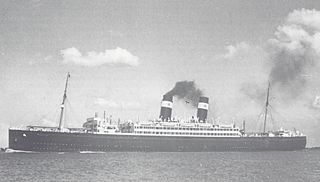
SS Pennland was a transatlantic ocean liner that was launched as Pittsburgh in Ireland in 1920 and renamed Pennland in 1926. She had a succession of UK, German and Dutch owners and operators. In 1940 she was converted into a troopship.
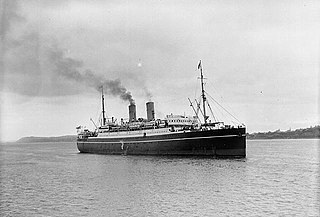
SS Metagama was a transatlantic ocean liner That was launched in 1914 and scrapped in 1934. The Canadian Pacific Railway Co owned her and the Canadian Pacific Steamship Co operated her. She was a pioneering example of a "cabin class" passenger ship.









